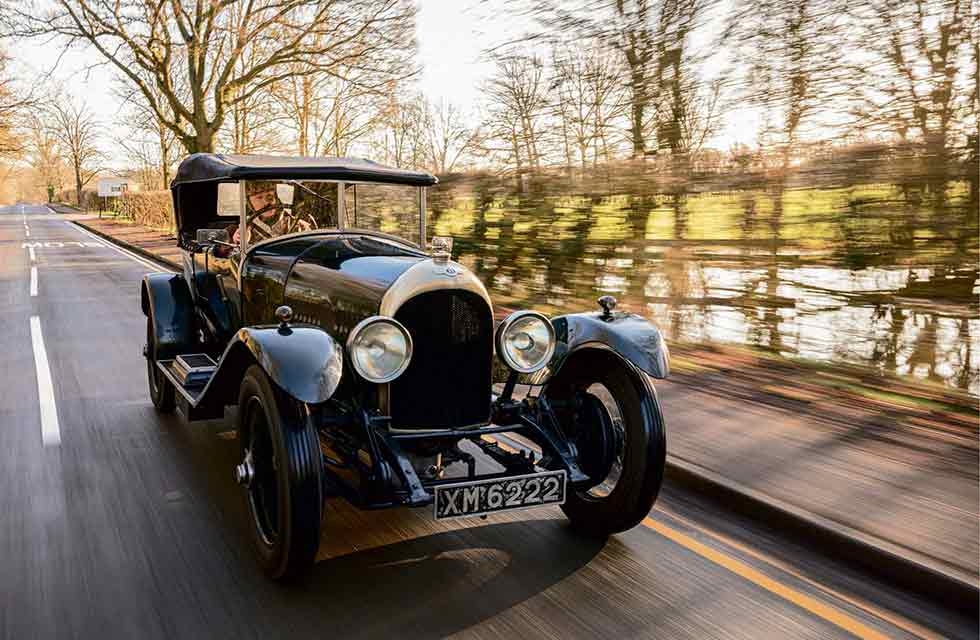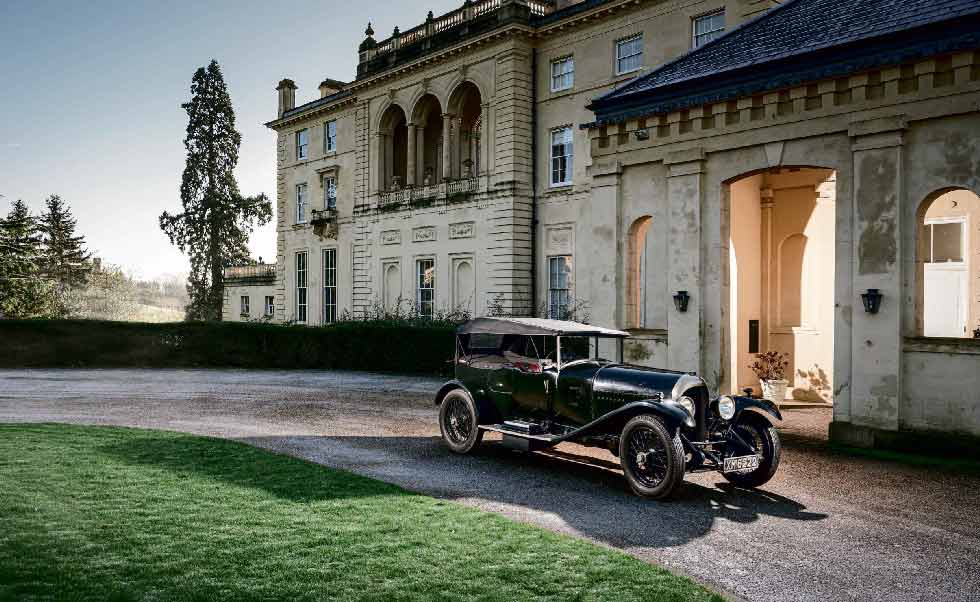
Biggest is not always best: Mark Dixon gets to grips with a very original Bentley 3 Litre and examines the appeal of these early cars Words Mark Dixon. Photography Paul Harmer.
FIRST OF THE FEW
Driving Cricklewood’s 1923 timewarp
Whoosh! A jet of water shoots up from the floorboards of the Bentley, giving me a bracing shower that’s as surprising as it is freezing cold. Hammering through a sheet of standing water for the photographer’s benefit. I’d forgotten that vintage cars tend to have separate wooden boards rather than one-piece floorpans, and now I have water beading on the inside of the windscreen while the outside is bone-dry.

‘Connoisseurs know that the 3 Litre is a car to quietly appreciate’
I am enjoying the drive so much, however, that the absurdity of the unexpected drenching just makes me laugh out loud, the car can take it, that’s for sure. Its owner, an ex-pat Brit and long-time resident of Los Angeles, Paul Lee – who was president of ABC Television for several years – is notably unprecious about using his Bentley, and using it hard, the day after our photoshoot, the car was due to be shipped out to South Africa for Paul to drive on a Bentley Drivers Club rally.
‘It’s only the Brits who are mad enough to do that!’ laughs Paul down the line from LA, when I call him a few days later. ‘Most of my friends here have Porsches and can’t understand why I want to drive such an old, heavy car. But that’s the joy of it – you have to do about eight things just to get it started in the morning.’
OK, he’s exaggerating, but only slightly. Fortunately, my first drive in Paul’s 1923 Bentley 3 Litre Tourist Trophy Replica is under the guidance of Steve Russell from specialist NDR Ltd (Neil Davies Racing, as was), and it begins at the spectacularly appropriate venue of Bentley Priory – appropriate not only because of its name, but because this 18th/19th Century stately home was the headquarters of RAF Fighter Command during the Battle of Britain. Parked outside the Priory’s grand entrance, the 3 Litre could easily have been timewarped here from 1940, waiting patiently for a squadron leader to return from his meeting with the ‘brass hats’.

In part, that period evocativeness is due to this car’s unusual originality. It had an engine change half a century ago but the body remains as Park Ward made it, with alloy panels over a wooden frame. ‘It’s one of maybe fewer than 100 vintage Bentleys that still have their original bodies,’ says Steve. ‘Bentley liked to use Vanden Plas because its works were next door to Bentley’s, but Park Ward’s workmanship was better. Trouble was, the alloy tended to crack as the chassis and body flexed.’
If you look hard enough, you can see one or two incipient cracks where 97 years have left their mark, but they only add to the glorious patination of this survivor, which has been used and enjoyed pretty much continually since new. So let’s find out why chassis 160 has exerted such a particular hold over its owners.
The right-hand-mounted gearlever and external handbrake preclude having a door on the offside, so you enter from the front passenger’s door and slide across the wide seat cushions to get behind the wheel. Ahead is a vee-shaped wooden dash; below that, the pedals are arranged with a centre throttle, brake to the right, as with many 1920s cars.
Check the hand-throttle on the steering wheel is open just a fraction, and that ignition is fully retarded. Pull out both of the magneto switches, to the right of the wheel (this car runs on its original magneto set-up), turn on the fuel pump – a rare non-original addition – and check the gearlever is in neutral; then, bringing your right foot over to depress the clutch, use your left to operate the starter button that’s tucked up and under the bulkhead. As soon as the engine grumbles into life, advance the ignition fully, and it idles with a loping gait that brings back schoolboy memories of double decker bus diesel engines, where you could seemingly hear every crankshaft revolution.
Now for the gearbox… Vintage Bentley ’boxes can be notoriously tricky, and it doesn’t help that every one seems to be different. Being a TT Rep, this 3 Litre is fitted with an A-type gearbox, and it’s actually not too bad. First to second is easiest if you keep revs to a minimum and short-shift, double-declutching and pausing just a second between gears. You can use more revs, but then you have to wait an age for them to drop before changing up, so low revs are much easier for consistency.
Second to third needs medium revs and a really quick action across the gate and forward – if you can feel the lever ‘suck’ out of second easily, it will be a totally silent change – but it’s frustrating how easy it is to get this wrong, which will result in horrendous crunching.
‘Vintage Bentley gearboxes are tricky, and every one seems to be different’
You then have two options: either to force it through – ‘You’ll break your wrist before you break the gearbox’, says Steve, reassuringly – or double-declutch down into second and try again. Or, if the road is quiet, just come to a complete halt and start from scratch, here’s no shame in that.
Third to fourth is again easiest if you keep the revs low, in which case it’s a straight pull and the lever will snick into place, but higher revs just need a slight pause halfway through. Downchanges are surprisingly straightforward (praise the Lord!), provided that you double-declutch and give the engine plenty of revs in between; more than you might initially expect.
Of course, much of the satisfaction when driving a vintage car is in learning its individual foibles, the Bentley was Paul Lee’s first pre-war car, although he already owned several post-war classics, and he pretends: ‘It took me three months to properly master the gearbox, and then another three months to master it when I was going up- or downhill.’
When this car was built, Bentley had been making production cars (as opposed to prototypes) for barely 18 months, so its claim that each the Replica was guaranteed to do 90mph around Brooklands was really something, the model name capitalised on Bentley’s success in the 1922 Isle of Man Tourist Trophy, where near-standard 3 Litres finished second, fourth and fifth against race-spec Sunbeams and Vauxhalls. The TT Rep’s engine – a big in-line four, each cylinder having four overhead valves – ran a higher compression than a standard 3 Litre’s but retained a single carburettor; this car, however, now runs the twin SU G5 ‘slopers’ fitted to Speed models from 1925 onwards, that’s because, in the mid-1960s, the original engine was replaced by a later unit rebuilt to Speed spec.
these days, separating a Bentley from its original engine would be frowned upon, but 55 years ago people worried less about ‘matching numbers’ – and, of course, this car has now had the later engine for well over half its life. It suits it well, pulling vigorously and emitting what you might call a ‘burble-lite’ version of the 4 ½ -litre’s bassy beat, although its exhaust note is completely drowned out by gear whine when you accelerate, the 3 Litre may not have the ultimate torque of its bigger-engined siblings but there’s still enough that you can easily take off in second gear from anything above a dead stop; co-pilot Steve shows me a nifty trick by which, if you’re coasting up to a junction, you can slip the gearlever into neutral and then pull it sharply into second without revving the engine first. Amazingly, the lever snaps straight into gear and you’re ready to go, if the coast is clear.
With its four-speed ’box, the 3 Litre is a great A-road cruiser. You sit high, as in a Range Rover, and the Bentley’s patrician radiator, black paint and apparently scowling vee windscreen are enough to intimidate any upstart modern. It looks even more ‘gangster’ with the hood raised, emphasising the body’s long horizontals, and it has the legs to run with traffic on a fast road, the beam-axle suspension is pretty well controlled over bumps and camber changes, while the steering is precise and solid-feeling. At parking speeds, it is of course a nightmare, but that’s the price you pay for directional accuracy when pressing on.
While the Bentley is never hard work to drive, you have to engage with it and keep focused at all times, particularly if the roads are wet, in which case the handling can become very skittish. Like all early Bentleys, this 3 Litre was built with rear-wheel brakes only but it was converted to four-wheel brakes in 1938, using a secondhand front axle and some parts supplied by the factory, they work fine most of the time, only occasionally becoming a little confused and pulling you towards the verge. Just enough to keep you on your mettle.
Paul Lee clearly relishes the challenge of driving his Bentley, but he also loves its history. Chassis 160 was bodied in January 1923 and sold to a Mr Cowan Shankland, who was a stockbroker, keen golfer and, it seems, friend of WO Bentley. A pretty stereotypical 3 Litre customer, in other words. However, the second (and fourth!) owner would turn out to be much more interesting.
Ashley Havinden had an amazing career, by any standards. After leaving school with no qualifications, he was offered a job at the WS Crawford advertising agency in 1922, aged 19. His instinctive ability for graphic design meant that by 1929 he was art director and he quickly became one of Britain’s most distinguished advertising artists, famous for his bold poster designs in which the text and fonts played as much of a graphic role as the illustrations.
Success made Havinden wealthy, and as early as October 1926 – when he was just 23 years old – he was able to buy this Bentley. It may well be the inspiration behind one of his early posters for BP, which features the turret- top silhouette of a racy 1920s tourer, and it’s mentioned in his prologue to Michael Frosticks 1970 book Advertising And The Motor Car. For reasons unknown, Havinden sold the Bentley to his copywriter ‘Bingy’ Saxon Mills in 1928, but he soon bought it back – presumably because he was fond of the car, since he appears to have kept it throughout the 1930s, when he could well have afforded to replace it.
Post-war, the 3 Litre had a slew of further owners, beginning with an Arthur Williams in 1946. Mr Williams also seems to have been unable to let the car go, because he sold it the same year, only to re-acquire it in 1949. Curiously, Arthur Williams had the Bentley re-registered as PV 9472, which seems to have been a blatant tax fiddle: ‘new’ cars attracted a flat £10 rate of vehicle excise duty, whereas older ones were still taxed by horsepower – which worked out at £20 for a Bentley 3 Litre. By claiming that the Bentley had been ‘rebuilt’ and fudging the chassis number so that it appeared slightly different on subsequent registration documents, Williams was able to pay the lower tax rate, even though it was one-and-the-same car. It seems that several vintage Bentleys were subject to the same ploy in the early post-war years, with chassis numbers invented by their owners!
Now reunited with its original registration, the 3 Litre also wears its correct chassis number – which Paul Lee recalls frustrating an LA policeman when he’d left the car illegally parked on Mulholland Drive, the cop, who was trying to issue him with a ticket, couldn’t believe a car might only have a three-digit chassis number instead of the usual complex VIN sequence of letters and digits. Paul never did receive the citation.
While the larger-engined Bentleys, from the 4 ½ Litre upwards, are the ones that today’s buyers tend to favour, seduced as they are by fantasies of ‘Blowers’ at Le Mans and the assumption that bigger is always better, connoisseurs know that the 3 Litre is a car to quietly appreciate for its balanced handling, elegant proportions and understated looks. Just ask Paul Lee.
‘I’ve not been able to drive the car for three months and I’m really going through the DTs!’ he laments. ‘I never realised, when I bought it sight-unseen, just how charismatic it would turn out to be. It’s an amazing witness to history as well as a wonderful car.’
THANKS TO Bentley Priory Museum, Stanmore, Middlesex HA7 3FB. Owned by the Air Ministry from 1926 to 2008, thePriory has since been beautifully refurbished and its museum is open on Mondays, Wednesdays, Fridays and Saturdays: bentleypriorymuseum.org.uk. Thanks also to Neil Davies and NDR Ltd, ndr.ltd.uk.
Clockwise from above: Bentley can prove skittish on a wet road; this car may have inspired 1920s poster; engine is to Speed spec; driver must enter from passenger’s side; weeshaped dash to match ’screen.
1923 Bentley 3 Litre TT Replica
Engine 2996cc four-cylinder, 16-valve, SOHC, two SU G5 carburettors (1925-spec Speed engine)
Max Power c90bhp @ 3600rpm
Max Torque 165lb ft @ 1650rpm
Transmission Four-speed non-synchromesh manual, rear-wheel drive
Suspension Beam axles, semi-elliptic leaf springs, friction dampers
Brakes Four-wheel mechanical drums (originally drums on rear wheels only)
Weight c1600kg
Top speed c90mph







